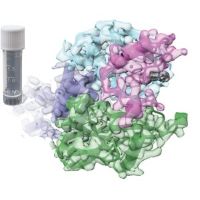Specification
| Description | Recombinant protein from the full-length sequence of Homo sapiens potassium channel tetramerization domain containing 17 (KCTD17), transcript variant 2 (NM_024681). |
| Organism | Homo sapiens (Human) |
| Expression Host | Human Cells |
| Tag Info | His or DYKDDDDK. Please contact us if you need further information or require specific designed tag. |
| Purity | Greater than 90% by SDS-PAGE gel |
| Uniprot ID | Q8N5Z5 |
| Entry Name | KCD17_HUMAN |
| Gene Names | KCTD17 |
| Alternative Gene Names | |
| Alternative Protein Names | BTB/POZ domain-containing protein KCTD17 |
| Application | Antigens, Western, ELISA and other in vitro binding or in vivo functional assays, and protein-protein interaction studies; For research & development use only! |
| Buffer | Purified protein formulated in a sterile solution of PBS buffer, pH7.2, without any preservatives |
| Endotoxin | Endotoxin level is < 0.1 ng/µg of protein (<1EU /µg) |
| Length | 321 |
| Molecular Weight(Da) | 35670 |
| Protein Sequence | (The sequence of expressed protein may have some variation from the sequence shown below. Please contact us for the exact sequence.) MQTPRPAMRMEAGEAAPPAGAGGRAAGGWGKWVRLNVGGTVFLTTRQTLCREQKSFLSRLCQGEELQSDRDETGAYLIDRDPTYFGPILNFLRHGKLVLDKDMAEEGVLEEAEFYNIGPLIRIIKDRMEEKDYTVTQVPPKHVYRVLQCQEEELTQMVSTMSDGWRFEQLVNIGSSYNYGSEDQAEFLCVVSKELHSTPNGLSSESSRKTKSTEEQLEEQQQQEEEVEEVEVEQVQVEADAQEKAQSSQDPANLFSLPPLPPPPLPAGGSRPHPLRPEAELAVRASPRPLARPQSCHPCCYKPEAPGCEAPDHLQGLGVPI |
Background
| Function | FUNCTION: Is a positive regulator of ciliogenesis, playing a crucial role in the initial steps of axoneme extension. It acts as a substrate-adapter for CUL3-RING ubiquitin ligase complexes which mediate the ubiquitination and subsequent proteasomal degradation of TCHP, a protein involved in ciliogenesis down-regulation (PubMed:25270598). May be involved in endoplasmic reticulum calcium ion homeostasis (PubMed:25983243). {ECO:0000269|PubMed:25270598, ECO:0000269|PubMed:25983243}. |
| Pathway | |
| Protein Families | |
| Tissue Specificity | Highly expressed in brain. Highest expression is observed in the putamen and the thalamus. {ECO:0000269|PubMed:25983243}. |
QC Data
| Note | Please contact us for QC Data |
| Product Image (Reference Only) |  |

